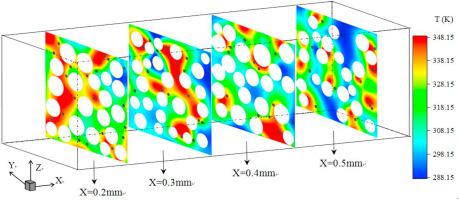Journal of Petroleum Science and Engineering Pub Date : 2020-09-28 , DOI: 10.1016/j.petrol.2020.107974 Haoting Li , Shuyan Wang , Ruichen Wang , Yang Liu , Baoli Shao , Zihan Yuan , Yujia Chen , Yimei Ma

|
Mastering flow and heat transfer of fluids in porous media is significant in the development of oilfield. A three-dimensional porous model with anisotropic pore structure is developed, and flow and heat transfer behaviors of particles are simulated using CFD-DEM method incorporating with the coupled convective-conductive heat flow model. The interphase forces including drag force, lubricating force and thermophoretic force are considered comprehensively. Comparisons of the predicted results are also made and in a good agreement with the classical experimental results by Rimon. Simulation results show that the temperature in porous media rises along with the mixing and contact between particles and liquid. The migration of moving particles is restricted in pore spacing, and thus narrows the apertures of fluid channel, increases the local instantaneous liquid velocity. Moving particles are preferred to decelerate and deposit at a low porosity. The velocities of particles and frequency of collision increase while contact force and granular temperature decrease with an increase of porosity. With the increase of particle temperature, the temperature gradient around hot particles enlarges and the number of trapped particles goes up affected by thermophoretic force. The intensity of convection heat decreases at lower liquid velocity, and the heat conduction between particles is regarded as the main heat transfer mechanism.
中文翻译:

颗粒流动行为及其对多孔介质传热影响的模拟
掌握多孔介质中流体的流动和传热在油田开发中具有重要意义。建立了具有各向异性孔结构的三维多孔模型,并结合耦合对流传导热流模型,采用CFD-DEM方法模拟了颗粒的流动和传热行为。综合考虑了相间力,包括阻力,润滑力和热泳力。还对预测结果进行了比较,并与Rimon的经典实验结果很好地吻合。仿真结果表明,多孔介质中的温度随着颗粒和液体之间的混合和接触而升高。运动粒子的迁移受到孔间距的限制,从而缩小了流体通道的孔径,增加局部瞬时液体速度。移动颗粒优选以低孔隙率减速和沉积。随着孔隙率的增加,颗粒的速度和碰撞频率增加,而接触力和颗粒温度降低。随着粒子温度的升高,热粒子周围的温度梯度增大,被热泳力的影响,被捕获粒子的数量增加。在较低的液体速度下,对流热的强度降低,并且颗粒之间的热传导被认为是主要的热传递机制。随着粒子温度的升高,热粒子周围的温度梯度变大,被困的粒子数量增加。在较低的液体速度下,对流热的强度减小,并且颗粒之间的热传导被认为是主要的热传递机制。随着粒子温度的升高,热粒子周围的温度梯度变大,被困的粒子数量增加。在较低的液体速度下,对流热的强度减小,并且颗粒之间的热传导被认为是主要的热传递机制。











































 京公网安备 11010802027423号
京公网安备 11010802027423号